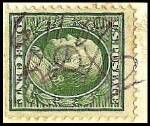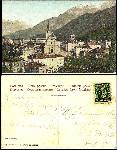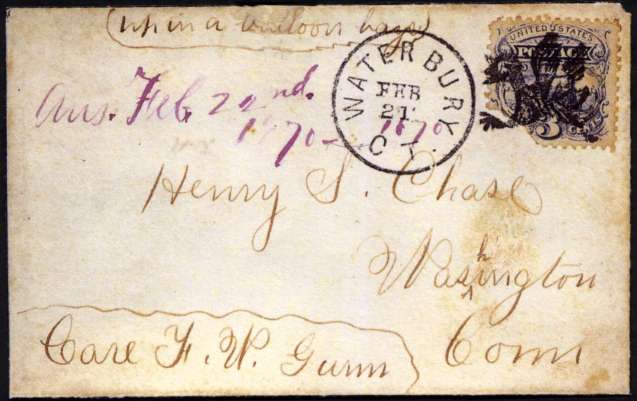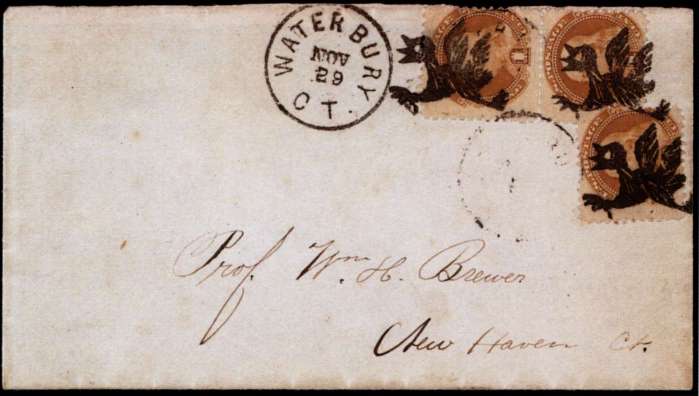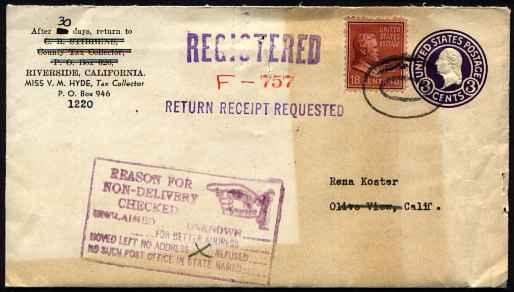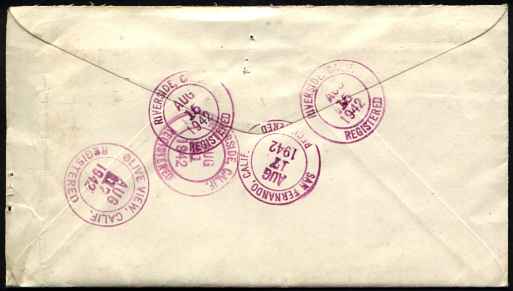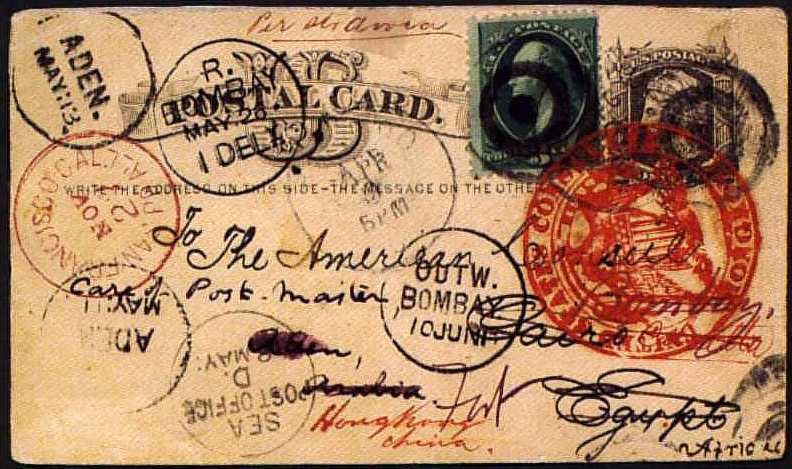

H is for Handstamp - Page 1 |

|

|

|

|
A Handstamp is "a postal marking applied by hand with a predefined marking device," usually using an inkpad and stamping device, whether as a cancellation, postmark, routing mark, or other processing notice (e.g., the Pointing Hand, "Return to Sender", "Received Without Contents"). Rare today, they were common and varied in the early days of our postal service, and their collection and study are popular, both among Postal Historians and general collectors. Important collections have been assembled based on single types of handstamps, such as Killers, Pointing Hands, CDS's (Circular Date Stamps), Backstamps, Special Service Markings, Fancy Cancels, etc.
Let's talk about some of those terms, as they may not mean much to non-philatelists.
A Cancel is a postal marking that is intended to "cancel" a postage stamp, i.e. mark it indelibly so it cannot be used again. We're all familiar with these, they (should) show up on most of our mail. But most of the ones we see today are machine cancels, applied by high-speed automated sorting and cancelling equipment. Most hand cancels date from the years before 1890, though you can still get one if you present your mail to a postal clerk and ask for it.

Those early hand cancels varied widely in form, and were often quite fanciful.
Modern (machine) cancellations are usually a set of parallel bars or wavy lines.

|
A Killer or Obliterator is a
dark, heavy cancellation. In the early days of U.S. stamps the killer was
often just a large black blotch that obscured the stamp entirely. |

|
A Fancy Cancel is a form of killer that was popular for a while in the 19th century, with an elaborate design depicting an animal, a bird, a geometrical figure, etc. |
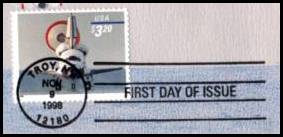
|
A First Day Cancel is a
special hand cancel applied on request to a letter bearing
a new stamp on its day of issue, i.e. its First Day, and usually including the text "FIRST DAY OF ISSUE." |

|
A Pictorial Cancel or Event Cancel is a
special hand cancel created to commemorate an event such as an anniversary, and usually including
an image appropriate to the event. |
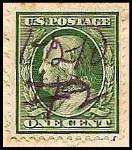
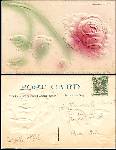 Examples above courtesy of Joan Blank, historian and postcard collector, who found these among her grandfather's papers. He lived on RFD#2, Hughesville, PA. The top one is dated 1/12/10 and the bottom 6/11/09; also marked #2 and RD#2. Visit Joan's blog and learn about her soon-to-be published book of Hughesville, PA postcard history. The early 20th century was the heyday of postcards - Joan wrote me that in her research she "found numerous references to invitations to 'postal card showers' ? they got together and gave each other postcards!" |
Rural Carrier's Hand Cancel 3/7/2007 - Viewer David Cowell of Tucson, AZ wrote as follows:
If we limit the definition of Handstamp as I did above, "a postal marking applied by hand with a predefined marking device," then this doesn't fit here, but I've decided to stretch the definition to include it. That opens the door to other hand-written postal markings, of course, such as the notorious X-cancel, which I discuss HERE. I did a quick search of the postal regulations in the USPS web site, and found nothing there about duties of rural mail carriers, but googling the topic led me to the site of the National Rural Letter Carriers Association, where I found "USPS pub PO-603 Rural Carriers Duties and Responsibilities," which indeed spells out the procedure David described:
4/23/07 - PO-603 has disappeared from the NRLCA site, but here's a link to another copy. Or if you prefer it in pdf form, here that is. |
A Postmark is a postal marking that tells where and when a piece of mail was processed in some way. It usually
includes the name of a town and state, and a date and time. All first-class mail is supposed to have a postmark
showing where and when it entered the mail stream. Postmarks may be added during a piece of mail's journey,
showing where it stopped along the way, though that is uncommon today. Most postmarks are circular.
Some do double duty as cancellations. Like cancels, most modern postmarks are applied by machines,
at the same time as the cancel.
A Circular Date Stamp (CDS) is a postmark in circular form, including city, state, and date. EXAMPLE
A Round Date is what Postal employees call a CDS. Some sites I checked use "round date" to mean only the large double circle cancel used at post office windows. Others use it interchangeably with CDS.
A Backstamp is a postmark applied to the back of an envelope. (EXAMPLES) At one time, most mail in the U.S. was backstamped with a CDS upon arrival at its destination post office. The only backstamps I know of that are used in the U.S. today are the CDS's applied to Registered Mail. But see below for an interesting way one reader suggests using backstamps.
A Favor Cancel is a postmark or cancel applied at the request of a patron, usually to a "Handback," i.e., a cover that is not to be mailed, and is returned at once to the patron. Collectors do this to create souvenirs.
Most non-philatelists use the terms postmark and cancel interchangeably, and do not think of the two as different, since they are usually applied at the same time, and as a unit, but to a collector, the distinction is important.
Note that a postmark can serve as a cancel, which adds to the confusion of the uninitiated.
An Auxiliary marking is some other form of handstamp or postal marking, neither a cancel nor a postmark. Note that while most terminology for postmarks and cancels is fairly standard among philatelists, terminology and definitions for auxiliary markings are less so.
A Source Marking is a postmark such as SHIP, STEAMBOAT, RAILROAD from the earliest days of government postal service, showing where a cover originated.
A Special Service Marking is a handstamp that indicates special handling such as Registered, Via Air Mail, or Special Delivery. Today special services are usually indicated by labels.
A Routing Mark is a postal marking added, usually after an item's first entry into the mails, to redirect it; e.g., to forward or return it after initial delivery fails. The Pointing Hand is a type of routing mark.
Other markings such as Missent, Received Without Contents, Damaged In Handling, are informational messages, usually to the recipient, basically CYA efforts to explain or excuse some deficiency in the handling or delivery of the piece of mail.
Some of these types of handstamps are illustrated and discussed further below.
And by the way, if you're puzzling over the artist's stamp to the right above (where's the H?),
the hand there is signing the letter H in International Sign Language!
Click on any image below to view a high-res version
Fancy Cancels


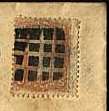
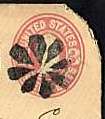

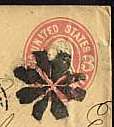

The standard postal markings on most covers - usually applied mechanically for most of
this century, hence not handstamps - consist of two separate elements: the postmark,
which is the part, usually circular, that contains the city and date of mailing; and the
cancellation, which is the bars or lines or whatever that are intended to mark or cancel
the stamp and prevent its re-use. Those markings have become very standardized and
mundane, and today their form is dictated or controlled by the postal authorities in
Washington, DC.
But there was a period, in the early days of stamps in this country (until 1890), when local postmasters were permitted to create their own cancels, and many of them took advantage of the opportunity to create very fanciful designs, by whittling the ends of corks, or small blocks of wood. The ones above are typical of the more ordinary, and can be purchased for $5 to $50 each, depending on the stamp, condition, and scarcity of the design.
WATERBURY FANCY CANCELS


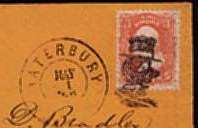


John W. Hill, the postmaster at Waterbury, Connecticut from 1869 to 1886, was especially
imaginative and skilled at creating his cancels, and good examples like the ones above
sell for hundreds, even thousands of dollars. Either his wore out quickly, or he simply
discarded them after some set period, because while he produced many different designs
over a fairly long period, and achieved recognition even during his lifetime (he died in
1921), he used each cancel a relatively small number of times, making good examples
scarce.
The two covers below bear the most famous and desirable fancy cancel - John Hill's "Running Chicken", used for only a short period in 1869-70. Some people think it's a turkey, since it was first first used around Thanksgiving in 1869, but the auction catalog from which I scanned the image on the left (Siegel Auction Galleries, September 27-28, 1994) says it was "based on a popular return address imprint of the period showing a freshly hatched chick chasing a fly (If you don't catch 'em in five days, etc.)".
The cover on the left last sold for $11,000 (I've yet to read a plausible explanation of
the sender's strange note at the top of the cover - does it say "Up in a balloon boys"?),
while the one on the right is valued at over $100,000, and is considered one of the
aristocrats of philately.
Handstamps tell a story
This cover illustrates one of the reasons many people enjoy postal history - postal
markings can tell a story, and there's often an element of mystery.
The postage is correct, the 3¢ indicium on the postal stationery covering the basic
first-class rate, and the 18¢ Prexie covering the 15¢ for Registration plus
3¢ for Return Receipt.
The handstamps, in the sequence they were most likely applied, are as follows:
1. "REGISTERED", front
2. Registration number - "F-757", front
3. "RETURN RECEIPT REQUESTED", front
4. Double oval cancellation, front
5 and 6. Two "REGISTERED" Circular Date Stamps, Aug. 15, 1942, Riverside, back
7. "REGISTERED" Circular Date Stamp, Aug. 17, 1942, San Fernando, back
8. "REGISTERED" Circular Date Stamp, Aug. 17, 1942, Olive View, back
9. Pointing hand, front
10. "REGISTERED" Circular Date Stamp, Aug. 21, 1942, Riverside, back
There are two sets of staple holes, one in the top middle (visible on the back, in the middle of the top flap); and the other on one edge (visible from the front to the right of the address).
Enclosed in the envelope is a notice warning the addressee that her property will be auctioned off for non-payment of taxes, unless she makes arrangements to pay them!
The story I read here is that the Tax Collector mailed the letter on Aug 15, at which time it received handstamps 1 through 6. The letter arrived in San Fernando (40 miles away) on Aug 17, and received handstamp #7. (August 15, 1942 was a Saturday, so the letter's arrival at its destination the following Monday is fine. Unusual perhaps to find the Tax Collector's office working on a Saturday!) That same day, Aug. 17, it was received in Olive View (right next door to San Fernando), received handstamp #8, and presumably delivery was attempted. Unable to find the addressee, the Olive View post office applied handstamp #9, the Pointing Hand, x'ed "MOVED LEFT NO ADDRESS", and returned the item to Riverside. On Aug 21 the letter arrived back in Riverside, and received its final handstamp before being delivered back to its source.
Minor mysteries -
1. I don't know what return receipts looked like at the time, but today the envelope would have pieces of the green form still attached. Perhaps it was stapled on, and that accounts for at least one set of the staple holes, though I would have assumed those were artifacts of its filing in the Tax Collector's office.
2. What caused the dramatic shading on the front of the envelope? It looks as though the left part was protected from light, while the right was exposed to it.
3. How did this cover get into the philatelic marketplace?
The real mystery, of course, is What happened to Rena Koster?
Round the World Cover
There was a period in the later part of the 19th century, when it first became possible to send mail almost anywhere in the world reliably and (relatively) cheaply, when imaginative souvenir collectors created covers like the one above (Siegel Auction Galleries Sale 774, March 27-28, 1996, lot 912, realized $950), which traveled around the world starting in Toldeo, Ohio in April 1880, simply to acquire all its postal markings - 13 of them. Its route included Cairo, Aden, Bombay, Hong Kong, and San Francisco. I can't read all the postmarks and stops, and some have no date, but the one from San Francisco is dated November 27, so the entire trip took at least seven months!
I don't know
whether just anyone could do this, or whether it required "connections" - certainly one
needed the cooperation of people along the way, but the idea was that one addressed a
card or cover to oneself or a friend at City A, and that person scratched out the address
and wrote a forwarding address in City B, and so on, until the last person returned the
cover to the original sender. The one above is particularly attractive for the
assortment, clarity, and placement of its postmarks, especially the bold red stamp of the
United States Consulate in Hong Kong. The message on the other side (this one is a postcard)
reads:
I wonder if one could do this today? In theory it should be possible, since I think
that all postal authorities still honor the principle that First Class mail is forwarded
and returned free of charge.
I have seen other "Round the World" cards/covers from the early 1900's using a
preprinted card divided into five or six boxes, each with space for a stamp and address.
**********************************************
One very rewarding result of these pages is the email I get from time to time. Here is
a condensed version of an exchange I had with a reader in March, 2001:
All Letter images Copyright © 1997, 2000, SF chapter of AIGA
Send feedback to the webmaster:
CLICK HERE
Revised -- 04/25/2007
Will you be so kind as to have this card forwarded through Arabia - India & China Across to Pacific
ocean to California & thence back. My object is to keep the card as a relic as having completed the circuit
of the globe.
I just want to let you know how much I enjoyed your H page. I ran across it while doing
some family history searching. It was so much fun to see my husband's great
grandfather's handwriting on one of the postcards. His name was David Bailey and he was
the First US Consulate to Hong Kong. He was promoted shortly after that to Consular
General in Singapore. His wife was the cousin of a Supreme Court Justice who has now
become famous as the only justice who voted against the Dred Scott Decision, Justice Harlan.
I wrote back, thanking the writer:
Thanks so much for writing - feedback like yours is my only reward for all the work I
have put into my pages, so it means a lot. I'm curious exactly what search led you to my
page? One of the things I try to find is stories that can add a personal element to the
material - I am amazed you were able to make that connection to the card I show on that
page - can you tell me more about how? Was it the handwriting? Or the mention of the
American consulate in Hong Kong and the date? I would like to quote you on the page, if
I may, as I think the coincidence is very appealing.
She replied:
Oh, we have seen that red stamp on a lot of family letters in the cedar chest
also.....They wrote a lot back then. My search was on consulate Hong Kong and Bailey.
Yours was item 36 in the search results. I checked the dates against family records and
realized that it was David's handwriting. We have it on his son's birth certificate. I
love stamps and postcards (inherited my mother in laws collection) and just plain enjoyed
the page.
(My thanks to Katie Leckey for her kind words about my page, and her permission to quote
her here.)
Home
G is for G stamp <<<
Contents
>>> H - Page 2
Credits
All text Copyright © 2000, William M. Senkus

